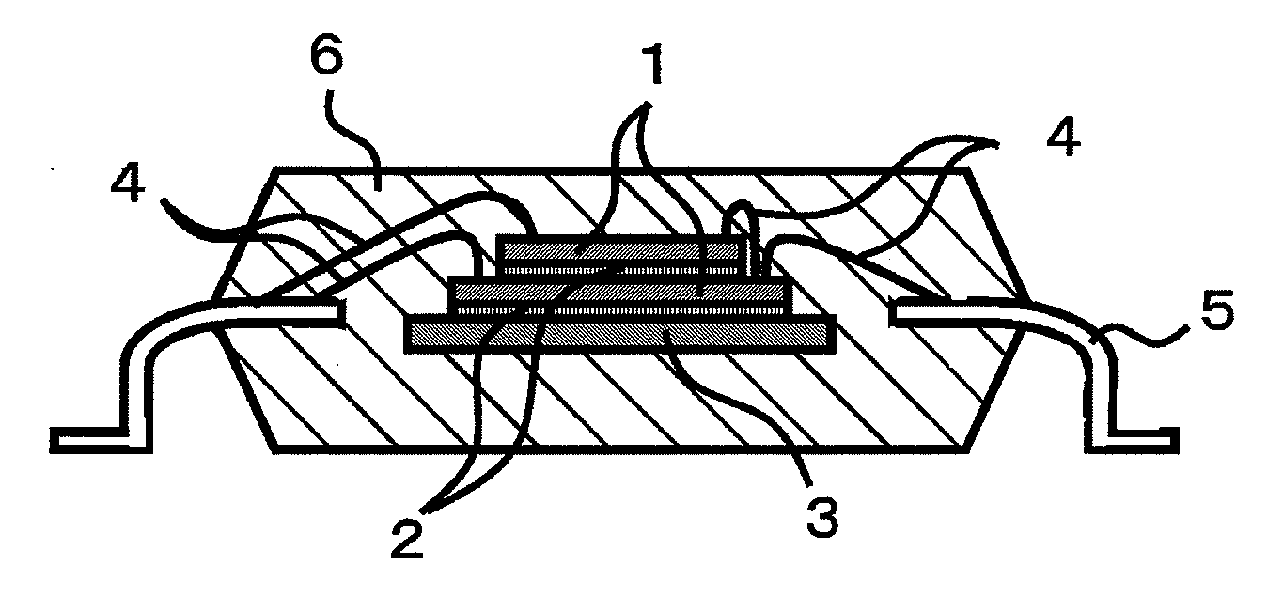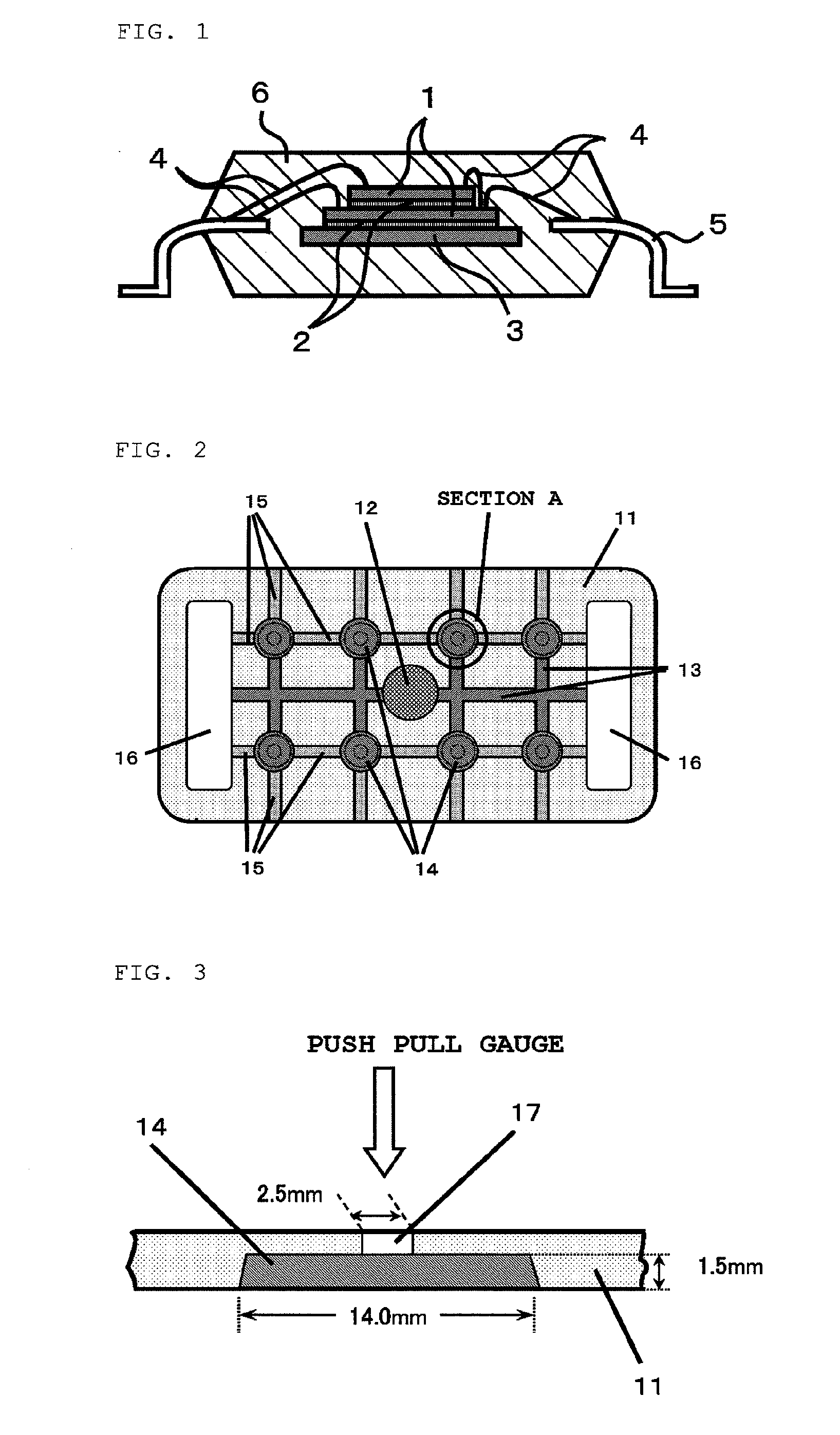Epoxy resin composition for semiconductor encapsulation, and semiconductor device using the same
a technology of epoxy resin and semiconductor encapsulation, which is applied in the direction of semiconductor devices, solid-state devices, basic electric elements, etc., can solve the problems of deterioration of releasability from molding molds, different surface states, and poor adhesiveness of semiconductor encapsulation materials to copper, etc., to achieve excellent releasability, excellent adhesiveness to copper, and continuous moldability
- Summary
- Abstract
- Description
- Claims
- Application Information
AI Technical Summary
Benefits of technology
Problems solved by technology
Method used
Image
Examples
synthesis example 1
Synthesis of Compound (E) Obtained by Esterifying Copolymer of 1-alkene Having 28 to 60 Carbon Atoms and Maleic Anhydride with Alcohol Having 18 Carbon Atoms
[0081]300 g of a copolymer of a mixture of 1-octacosene, 1-triacontene, 1-tetracontene, 1-pentacontene, 1-hexacontene and the like and maleic anhydride (trade name: DIACARNA (registered trademark) 30 manufactured by Mitsubishi Chemical Corp.) and 140 g of stearyl alcohol were dissolved in 500 ml of toluene, and the solution was allowed to react for 8 hours at 110° C. Subsequently, toluene was removed while the temperature was increased stepwise up to 160° C., and unreacted components were removed by carrying out the reaction for 6 hours at 160° C. under reduced pressure. Thus, 1,489 g of the target compound having a monoesterification ratio of 100% by mole was obtained. The molecular weight was measured by gel permeation chromatography by using tetrahydrofuran as an eluent, and calculated relative to polystyrene standards. The n...
synthesis example 2
Synthesis of Compound (E) Obtained by Esterifying Copolymer of 1-alkene Having 28 to 60 Carbon Atoms and Maleic Anhydride with Alcohol Having 10 Carbon Atoms
[0082]2,378 g of a compound having a monoesterification ratio of 100% by mole was obtained by the method described in Synthesis Example 1, except that 82 g of 1-decanol (manufactured by Tokyo Chemical Industry Co., Ltd.) was used instead of stearyl alcohol. The molecular weight was measured by gel permeation chromatography by using tetrahydrofuran as an eluent, and calculated relative to polystyrene standards. The number average molecular weight (Mn) was 3,700, the molecular weight distribution (Mw / Mn) was 3.71, and the residual amount of unreacted 1-decanol was 1% or less of the total amount of the compound 2.
synthesis example 3
Synthesis of Compound (E) Obtained by Esterifying Copolymer of 1-alkene Having 28 to 60 Carbon Atoms and Maleic Anhydride with Alcohol Having 22 Carbon Atoms
[0083]3,458 g of a compound having a monoesterification ratio of 100% by mole was obtained by the method described in Synthesis Example 1, except that 170 g of behenyl alcohol (trade name: KALCOL 220-80 manufactured by Kao Corp.) was used instead of stearyl alcohol. The molecular weight was measured by gel permeation chromatography by using tetrahydrofuran as an eluent, and calculated relative to polystyrene standards. The number average molecular weight (Mn) was 4,400, the molecular weight distribution (Mw / Mn) was 3.55, and the residual amount of unreacted behenyl alcohol was 1% or less of the total amount of the compound 3.
PUM
| Property | Measurement | Unit |
|---|---|---|
| temperature | aaaaa | aaaaa |
| temperature | aaaaa | aaaaa |
| time | aaaaa | aaaaa |
Abstract
Description
Claims
Application Information
 Login to View More
Login to View More - R&D
- Intellectual Property
- Life Sciences
- Materials
- Tech Scout
- Unparalleled Data Quality
- Higher Quality Content
- 60% Fewer Hallucinations
Browse by: Latest US Patents, China's latest patents, Technical Efficacy Thesaurus, Application Domain, Technology Topic, Popular Technical Reports.
© 2025 PatSnap. All rights reserved.Legal|Privacy policy|Modern Slavery Act Transparency Statement|Sitemap|About US| Contact US: help@patsnap.com



